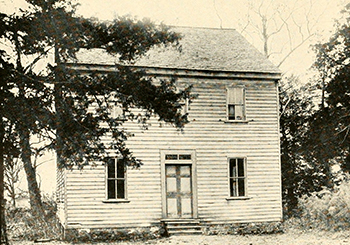Haywood, Egbert
1730–30 Sept. 1801
Egbert Haywood, Revolutionary patriot, was the son of Colonel John Haywood, a surveyor for Earl Granville and treasurer of the northern counties of the province of North Carolina, and Mary Lovett Haywood of New York. In 1773 he was one of eight commissioners appointed to contract with workmen to repair the "public goal" in the town of Halifax, and in 1774 he was one of three commissioners assigned to lay off and mark the line to divide Edgecombe Parish in Halifax County into two parishes.
The North Carolina Provincial Congress in August 1774 appointed Haywood one of eleven members of the Halifax County Committee of Safety. On 9 Sept. 1775, the Congress elected him second major of North Carolina troops for Halifax County, a position he held until 22 Apr. 1776. At the same session, he was appointed one of two men to procure arms and ammunition from the county for the Continental Army. When the Congress reconvened in November 1776, Haywood was elected to the vacancy left by one of its five members from Halifax County who resigned to accept an appointment in the Continental Army. He took his seat on 7 December. On 23 December, he was selected as a justice of the Court of Pleas and Quarter Sessions for Halifax.
Haywood represented Halifax County in the 1777 and 1778 sessions of the Congress as well as in the first  1779 session of the House of Commons, which was the lower house of the legislative branch of the new state government. Among other duties, he served on committees dealing with Indian affairs, privileges, and elections. In 1788, he was a commissioner for purchasing tobacco for the state in Halifax County. In July of that year, he represented his county in the convention at Hillsborough which had assembled to consider ratification of the Constitution. Haywood agreed with Halifax delegate Willie Jones, a leader against ratification on the ground that it would infringe on states' rights. Ratification was rejected by a vote of 184 to 84.
1779 session of the House of Commons, which was the lower house of the legislative branch of the new state government. Among other duties, he served on committees dealing with Indian affairs, privileges, and elections. In 1788, he was a commissioner for purchasing tobacco for the state in Halifax County. In July of that year, he represented his county in the convention at Hillsborough which had assembled to consider ratification of the Constitution. Haywood agreed with Halifax delegate Willie Jones, a leader against ratification on the ground that it would infringe on states' rights. Ratification was rejected by a vote of 184 to 84.
Haywood and his wife Sarah Ware had ten children: Dr. Lewis Green, who married Sarah Ann Cressy; Thomas, who was unmarried; William, who married Abby Jones; Dr. Henry, who married Sarah Ruffin; Mary, who married Captain Robert Bell; Jane, who married Marmaduke Johnson; Sarah, who married her cousin, Adam John Haywood; Margaret, who first married Edward Bignal and afterwards Oliver Fitts; Elizabeth, who married Colonel William Shepard; and Judge John, who served on the Supreme Court of North Carolina and later the Supreme Court of Tennessee. According to the census of 1790, Haywood enslaved 17 people and owned 1,500 acres of land. He was a Mason and a member of the Royal White Hart Lodge in Halifax.
References:
W. C. Allen, A History of Halifax County (1918).
Samuel A. Ashe, ed., Biographical History of North Carolina, vols. 3, 6 (1906, 1907).
Walter Clark, ed., State Records of North Carolina, vols. 12, 18, 21–23 (1885–1904).
Charles B. Gault, Haywood-Bell Genealogy (1968).
Hubert B. Haywood, Sr., Sketch of the Haywood Family in North Carolina (1956).
Margaret M. Hofmann, Genealogical Abstracts of Wills, 1758–1824, Halifax County, North Carolina (1970).
William C. Pool, "An Economic Interpretation of the Ratification of the Federal Constitution in North Carolina (Part 2)," North Carolina Historical Review 27 (1950).
William L. Saunders, ed., Colonial Records of North Carolina, vols. 9, 19 (1890).
Frederick G. Speidel, North Carolina Masons in the American Revolution (1975).
Additional Resources:
"CSR Documents by Haywood, Egbert, 1730-1801." Colonial and State Records of North Carolina. Documenting the American South, University of North Carolina at Chapel Hill. https://docsouth.unc.edu/csr/index.html/creators/csr11631 (accessed January 14, 2013).
Image Credits:
"Royal White Hart Lodge, Halifax, N.C." Allen, W. C. (William Cicero). History of Halifax County. Boston, The Cornhill Company. 1918. 96. https://archive.org/stream/historyofhalifax00allen#page/96/mode/2up (accessed January 16, 2013).
1 January 1988 | Haywood, John D.